Have you ever wondered how much caffeine is in a Hershey’s chocolate bar?
If so, you’re not alone, as many people may be curious about the caffeine content in their favorite sweet treats.
It turns out, the amount of caffeine in Hershey’s chocolate bars varies depending on the specific product, but generally speaking, it’s not a significant source of caffeine for most people.
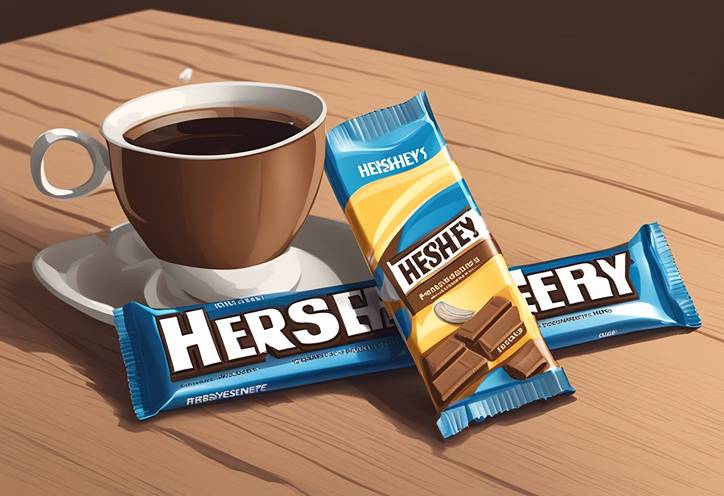
Hershey’s milk chocolate bars, for example, contain around 9 milligrams of caffeine per 1.55-ounce serving, which is significantly lower than the caffeine content in a cup of coffee or even a can of soda.
Dark chocolate bars and other Hershey’s products may have slightly higher amounts of caffeine, but overall, chocolate is not considered a major source of this stimulant when compared to other common caffeine sources.
Key Takeaways
- Hershey’s chocolate bars contain varying amounts of caffeine, depending on the specific product
- A standard milk chocolate bar has approximately 9 milligrams of caffeine, which is much lower than coffee or soda
- Dark chocolate and other Hershey’s products may have slightly higher caffeine amounts, but still not considered a major source compared to other caffeine sources.
Specific Hershey Products and Their Caffeine Content

How Much Caffeine is in a Hershey Bar?
A standard 1.55 oz Hershey’s milk chocolate bar contains only about 9 milligrams of caffeine, which is significantly lower than what you would find in a cup of coffee or even a can of soda.
This means that you can enjoy a delicious Hershey’s chocolate bar without having to worry too much about its caffeine content.
Special Dark Chocolate Bar
Hershey’s Special Dark Chocolate Bar contains a higher percentage of cocoa than its Milk Chocolate counterpart, resulting in a slightly higher caffeine content.
Though the exact amount may vary depending on the specific product, it will still be relatively low compared to other caffeinated beverages.
Even with its increased cocoa content, a Special Dark Chocolate Bar remains a low-caffeine treat.
Cookies ‘N’ Creme Bars
Hershey’s Cookies ‘N’ Creme Bars are primarily made from white chocolate, which contains minimal amounts of cocoa solids.
Consequently, the caffeine content in these bars is considerably lower than that of milk or dark chocolate.
You can rest assured that indulging in a Cookies ‘N’ Creme Bar will not significantly affect your caffeine intake.
Kisses
Hershey’s Kisses come in various flavors, from Milk Chocolate to Special Dark and many more. Like the chocolate bars, the caffeine content in Kisses varies depending on the specific flavor.
However, due to their smaller size, the caffeine content per piece will be considerably lower than a full-sized chocolate bar.
Enjoying a handful of Hershey’s Kisses should not cause any significant spike in your caffeine intake.
Hershey’s Product Varieties
Hershey’s offers plenty of chocolate options for everyone’s taste preferences.
The caffeine content in Hershey’s chocolate bars can range from as low as 6 milligrams in Milk Chocolate or Cookies ‘N’ Creme bars to slightly higher amounts in their Special Dark Chocolate varieties.
Despite these differences, overall, the caffeine content in Hershey’s products remains low, making them an ideal choice for those looking for a sweet treat without excessive caffeine.
Caffeine in Chocolate versus Other Sources

Caffeine in Coffee and Tea
While a Hershey’s chocolate bar contains around 9 mg of caffeine, the amount drastically varies when compared to other sources like coffee and tea. A standard 8-ounce cup of coffee typically has between 70 and 140 mg of caffeine.
On the other hand, tea generally contains lower amounts of caffeine, ranging from 15 to 60 mg per 8-ounce cup depending on the type and processing of the tea leaves.
When comparing chocolate to these sources, it’s evident that the caffeine content in a chocolate bar is significantly lower.
Moreover, the amount of caffeine in chocolate mainly depends on the percentage of cacao it contains.
Energy Drinks and Caffeine Pills
Energy drinks also have a considerable amount of caffeine, with some popular brands containing around 80-160 mg per 8-ounce serving.
This makes them a more potent source of caffeine compared to a Hershey’s chocolate bar. Energy drinks often contain additional ingredients such as taurine, guarana, and B vitamins, which contribute to their stimulating effects.
Caffeine pills, on the other hand, provide an even more concentrated form of caffeine, with a typical pill containing about 100-200 mg of caffeine.
This makes them a very potent source of caffeine when compared to chocolate, coffee, or tea.
In summary, a Hershey’s chocolate bar contains a relatively low amount of caffeine compared to other sources like coffee, tea, energy drinks, and caffeine pills.
However, it is essential to be mindful of your overall caffeine intake as sensitivity to caffeine can vary significantly from person to person.
Health Considerations and Caffeine Sensitivity
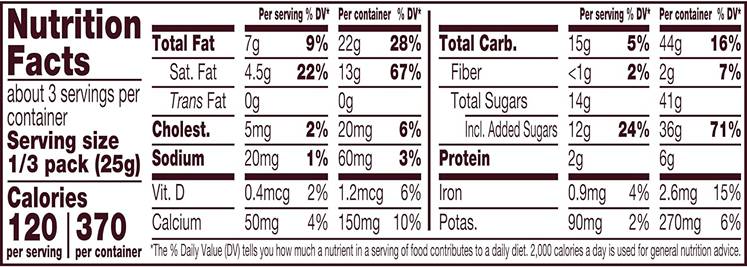
Effects of Caffeine on the Body
Caffeine is a natural stimulant found in a variety of food products, providing an energy boost and improving focus.
When consumed in moderation, it can offer some health benefits, such as increased alertness and mood enhancement.
However, if you are sensitive to caffeine, even small amounts like that found in a Hershey bar may cause symptoms such as nervousness, restlessness, and insomnia.
Organic sources of caffeine, such as those found in tea or coffee, may offer additional benefits due to the presence of antioxidants and other healthy compounds.
When incorporating caffeine into your diet, remember to choose quality products and consume them in moderation.
Caffeine and Sleep
Caffeine stimulates the central nervous system, which can lead to disrupted sleep patterns.
If you are sensitive to caffeine, it is essential to be mindful of your consumption, especially as bedtime approaches.
Consuming caffeine too close to bedtime can lead to insomnia and impact the quality of your sleep.
To minimize the effects of caffeine on your sleep, consider setting a cutoff time for consuming caffeinated products, such as several hours before bed.
Consumption Guidelines
For most healthy adults, up to 400 milligrams (mg) of caffeine per day appears to be safe.
This is equivalent to roughly four cups of brewed coffee or ten cans of cola.
However, it is essential to take the amount of caffeine found in various sources, including chocolate or energy drinks, into account when calculating your daily intake.
Here are some general suggestions for caffeine consumption, depending on your sensitivity level:
- Low sensitivity: You can consume up to 400 mg of caffeine per day without adverse effects.
- Moderate sensitivity: Limit your caffeine intake to 200-300 mg per day and avoid consuming it late in the day.
- High sensitivity: Consume less than 100 mg of caffeine daily and be cautious of potential side effects.
For children, caffeine consumption should be significantly limited.
The American Academy of Pediatrics recommends that adolescents consume no more than 100 mg of caffeine per day and younger children should avoid caffeine altogether.
Remember to listen to your body and adjust your caffeine intake accordingly, always considering personal sensitivities and individual health needs.
Certifications and Dietary Concerns
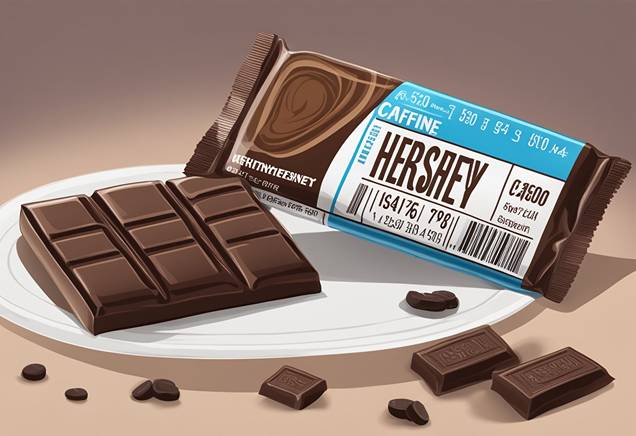
Organic and Kosher Certification
Hershey’s chocolate bars do not hold an organic certification. However, they do have a kosher certification provided by the Orthodox Union. This means that their products meet the requirements set by Orthodox Jewish laws.
To ensure the kosher certification, Hershey’s adhere to strict guidelines and has routine inspections to maintain their certification.
Gluten-Free and Dairy Considerations
When it comes to gluten-free and dairy considerations, it’s essential to be aware of a few factors. Most Hershey’s Milk Chocolate Bars contain dairy, as they are primarily made from milk, cocoa solids, and sugar.
However, specific varieties, such as Hershey’s Special Dark Chocolate Bar, have less dairy content but still may not be suitable for individuals with severe lactose intolerance.
In terms of gluten-free options, some Hershey’s chocolate bars are considered gluten-free since they contain less than 20 ppm (parts per million) of gluten.
It is the standard set by the FDA for gluten-free products. You should carefully read the product label to determine whether a particular Hershey’s chocolate bar is suitable for your dietary needs.
Keep in mind that while Hershey’s takes steps to reduce the risk of cross-contamination, their facilities may not be entirely free of gluten or dairy allergens.
It’s essential to consider your specific dietary restrictions and sensitivities when consuming any product.
Comparative Analysis of Caffeine Content

Comparison with Other Confectionery Products
When looking at the caffeine content in a Hershey’s chocolate bar, it is important to compare it with other confectionery products.
For instance, a Hershey’s milk chocolate bar contains about 9 milligrams of caffeine, which is significantly lower than what you would find in a cup of coffee or even a can of soda.
In comparison, 80% of dark chocolate have caffeine – it has around 35 milligrams of caffeine per 1.5-ounce bar.
The caffeine content in chocolate generally increases with the percentage of cocoa solids present, which explains the higher concentration of caffeine in darker varieties.
Caffeine in Popular Candy Bars
Here’s a list of some popular candy bars and their approximate caffeine content:
- 100% Dark Chocolate: Highly dependent on the brand and cocoa bean type, but it can contain up to 80 milligrams of caffeine per 1.5-ounce bar.
- Dagoba New Moon (74% Dark Chocolate): Around 25-30 milligrams of caffeine per 1.5-ounce bar.
- Dagoba 37% Milk Chocolate: Approximately 10-15 milligrams of caffeine per 1.5-ounce bar.
- Hershey’s Special Dark Chocolate Bar: With its 45% cocoa content, it has around 20 milligrams of caffeine per 1.5-ounce bar.
- Almond Joy Candy Bar: Slightly lower than Hershey’s milk chocolate due to the presence of almonds, at about 8 milligrams of caffeine per 1.5-ounce bar.
- Krackel Chocolate Bar: Its caffeine content is similar to Hershey’s milk chocolate, containing approximately 9 milligrams of caffeine per 1.5-ounce bar.
- Mounds Candy Bar: With coconut taking up a considerable portion of the candy bar, its caffeine content is lower than Hershey’s Milk Chocolate, at about 7 milligrams of caffeine per 1.5-ounce bar.
From the information provided, you can see that the caffeine content of various chocolate bars varies, depending on the type of chocolate and the presence of other ingredients.
The Chemistry of Chocolate and Caffeine

When it comes to chocolate, one of the primary components responsible for its flavors and effects is the combination of caffeine and theobromine.
Both of these compounds are found in the cacao plant, which is the main ingredient in the production of chocolate. In this section, we will explore the chemistry of chocolate and how the compounds caffeine and theobromine play a role in its makeup.
Theobromine versus Caffeine
Caffeine and theobromine are both alkaloids found in the cacao plant.
While they share some similarities in their chemical structures, there are key differences between the two.
Theobromine is primarily found in cocoa solids, whereas caffeine is present in both the cocoa solids and the cocoa beans.
Caffeine is known for its stimulating effects, which can be responsible for an increase in alertness and a temporary boost of energy.
It is typically found in higher concentration in dark chocolate, with 12 milligrams per ounce in dark chocolate (45 to 59% cacao solids) and even higher amounts in chocolate containing 70 to 85% cacao solids.
Theobromine, on the other hand, is a milder stimulant that contributes to the overall satisfaction and relaxation experienced when consuming chocolate.
Found primarily in cocoa solids, it plays a significant role in the chocolate-making process by contributing to the flavor profile of chocolate products.
When examining a Hershey’s milk chocolate bar, it contains about 9 milligrams of caffeine per 1.5-ounce serving, according to INTEGRIS Health.
This is important to keep in mind if you’re sensitive to the effects of caffeine or trying to monitor your daily intake.
In summary, the chemistry of chocolate is a complex and fascinating process that involves a delicate balance between the compounds caffeine and theobromine.
Understanding these chemical components can help you appreciate the nuances and flavors that each type of chocolate has to offer.
So, the next time you enjoy a Hershey bar, remember the intricate chemistry that goes into creating the taste and sensations you experience.
| Hershey’s Chocolate Bar | Caffeine Content (mg) |
|---|---|
| Hershey’s Milk Chocolate | 9 mg |
| Hershey’s Special Dark | 20 mg |
| Hershey’s Cookies ‘n’ Creme | 9 mg |
| Hershey’s Symphony | 18 mg |
Final Words
When it comes to the caffeine content in Hershey bars, it’s essential to understand that not all chocolate is created equal in terms of the levels of caffeine it contains.
A standard Hershey’s milk chocolate bar, recognized as a household name in American chocolate, carries small amounts of caffeine, reflective of the cocoa beans used in its production.
Typically, a 1-ounce serving of milk chocolate may contain about 6 to 9 milligrams of caffeine, which is significantly less than the caffeine found in darker chocolates.
This variance is primarily due to the higher cocoa content in dark chocolate, with a bar of dark chocolate potentially containing up to 20mg of caffeine per 1 ounce.
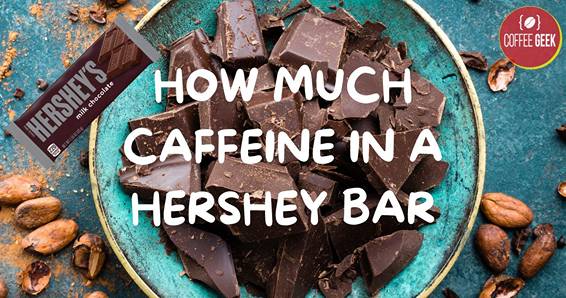
For those who prefer milk chocolate over its bittersweet counterparts, it’s comforting to know that indulging in a Hershey bar won’t provide the same level of caffeine as a cup of coffee.
However, for individuals sensitive to caffeine or monitoring their intake, even the small amounts in chocolate may be worth noting. The exact amount of caffeine can vary slightly depending on the specific product and the cocoa beans used.
Interestingly, the caffeine content is higher in dark chocolate due to the higher levels of cocoa solids.
For example, a darker color chocolate bar, which contains higher percentages of cocoa butter, will naturally have more caffeine.
This is why dark chocolate is often cited for having more health benefits, albeit with a higher caffeine content than milk chocolate.
In summary, while Hershey bars and other chocolate may contain caffeine, the amount is relatively low, especially when compared to other sources like coffee or energy drinks.
It’s important to remember that the indulgence in a Hershey bar offers more than just caffeine; it’s an experience of enjoying one of the many delicious and popular chocolate varieties that have become a staple in American confectionery.
It ranges from the classic milk chocolate to the richer, more intense dark varieties.
Frequently Asked Questions
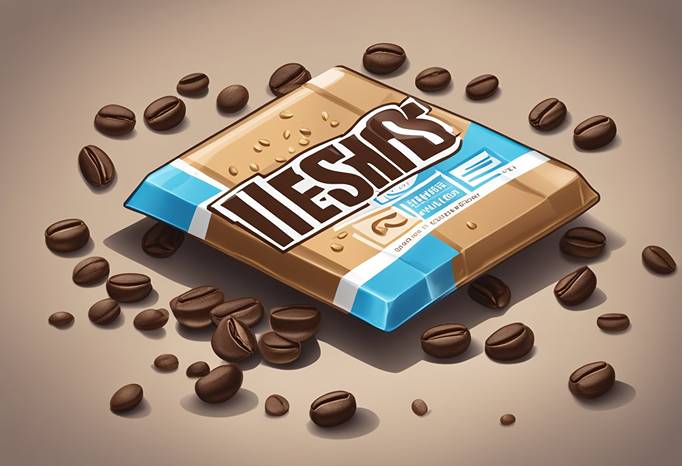
What is the caffeine content in Hershey’s Milk Chocolate bars?
A standard 1.55 oz Hershey’s Milk Chocolate bar contains approximately 9 milligrams of caffeine.
This amount is significantly lower than what you would find in a cup of coffee or even a can of soda, thus allowing you to enjoy the chocolate bar without worrying about excessive caffeine consumption.
Can you find caffeine in Hershey’s Cookies and Cream bars and if so, how much?
Yes, there is caffeine in Hershey’s Cookies and Cream bars. However, similar to the Milk Chocolate bars, the caffeine content is quite low.
A typical Cookies and Cream bar contains around 6 milligrams of caffeine per 1-ounce serving, which is even less than the amount found in Milk Chocolate bars.
What amount of caffeine is present in Hershey’s Dark Chocolate bars?
Hershey’s Special Dark Chocolate bars contain a slightly higher amount of caffeine compared to Milk Chocolate bars. A 1-ounce serving of Hershey’s Special Dark Chocolate contains around 12 milligrams of caffeine.
This is still a relatively low amount compared to other caffeinated products like coffee, tea, and energy drinks.
Are there different caffeine levels in regular versus King Size Hershey bars?
The main difference between regular and King Size Hershey bars is the size and weight, which ultimately affects the overall caffeine content.
However, the proportion of caffeine per ounce stays the same.
So, if you eat an entire King Size of the bar, you will consume more caffeine than if you eat a regular-size bar, but the concentration of caffeine per ounce remains consistent.
Does the size of the Hershey bar, like a Mini, affect its caffeine content?
The size of a Hershey bar does not affect the concentration of caffeine per ounce. However, the total caffeine content of the bar will be affected by the size.
A Hershey’s Mini Milk Chocolate bar will have less overall caffeine compared to a regular or King Size bar due to its smaller size, but the proportion of caffeine per ounce remains the same.
Is there any caffeine in a Hershey’s Kiss compared to a full chocolate bar?
Yes, Hershey’s Kisses contain caffeine as they are made from the same chocolate as Hershey’s bars.
The caffeine content in a single Hershey’s Kiss is lower than that of a full-size chocolate bar since it is smaller in size and weight.
However, the concentration of caffeine per ounce will be similar to that of a Hershey’s Milk Chocolate bar.

